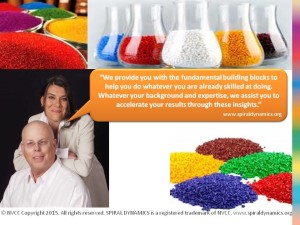What Is Your Biggest Problem?
What is your biggest problem? You know, the one that sucks your time, energy and attention; the one you’d dearly love to solve. If it were easy to fix, you would have done it by now, wouldn’t you? But it’s still there. You’ve looked at it using different perspectives and haven’t been able to crack that nut with the tools you’ve got. Something is missing.
If your big problem has to do with how people think, behave, believe, or make choices; if it’s interpersonal conflict or resistance to changes, then a Spiral Dynamics® program can put a nut cracker in your hand so you can break that shell and move forward.
These composite cases and reports come from messages and discussions we’ve had with our clients and the problems we’ve helped them to solve:
Strategic Insights
 ‘Mary Adams’ used what she learned in the Spiral Dynamics® program to administer and interpret the Spiral Dynamics® assessments, then used the results to help her organization complete a strategic market analysis. Through those insights the organization completely revitalized the way it presented itself to its market. They refocused their attention on a growing market segment that emerged more clearly and which they had previously missed entirely.
‘Mary Adams’ used what she learned in the Spiral Dynamics® program to administer and interpret the Spiral Dynamics® assessments, then used the results to help her organization complete a strategic market analysis. Through those insights the organization completely revitalized the way it presented itself to its market. They refocused their attention on a growing market segment that emerged more clearly and which they had previously missed entirely.
Coaching
‘Mark Jones’ applies what he learned in the Spiral Dynamics® program, administers the Spiral Dynamics® assessments and regularly uses the results to inform himself and hone his approach as he coaches executives and mentors other coaches. “This approach reveals things in people that we’d never see otherwise, both within individuals and in their organizations.”
‘Lisa Braun’ worked with the Spiral Dynamics® profiles she had clients complete prior to the Spiral Dynamics® program she attended. She then coached 3 of the 4 people. “I have been identifying the underlying currents with these tools and using them in my presentations, workshop exercises, asking questions and getting more involved with my clients’ businesses. Just explaining the basics of SD in the right way increases context awareness and improves communication in an organization. Also, I have found that an understanding of Spiral gives you another dimension when doing Life or Executive Coaching and when practicing NLP better enabling me to explain the hows and whys of behaviour to people. That can be a vital tool to have in the kit. All Coaching, Life Coaching Associations and NLP Trainers need this in their tool box.”
Restructuring Teams and Organizations
‘Jason Jackson’, a consultant, worked with a senior executive in a large government organization. She was about to launch into project management and a matrix structure. Jason applied what he learned in the Spiral Dynamics® program and administered the Spiral Dynamics® assessment suite. Based on the results he suggested why the approach she’d chosen would likely present some problems for her and her people. They did a reset and worked on a different, more congruent approach to minimize the stress and pain of the reorganization while accomplishing its objective.
Building a Healthy Corporate Culture
‘Jim Wright’, a corporate trainer and change agent, began using what he learned in the Spiral Dynamics® program. Using the Spiral Dynamics® assessments, he worked with us to build on the effectiveness of his organization’s existing programs. Internal clients responded in an exceptionally positive way, and he appreciates the way it is causing some serious reflection on their interactions with one another, their work, and their clients.
His CEO sent an email saying: “It might be ambitious, but my simple objective for ’ XYZ LLC’ is to make it the best possible place to work for everyone employed here. Not in a silly fuzzy way, but in a challenging, fulfilling, substantive way. Trying to adapt this organisation to its people and its clients risks that we slip into doing the exact opposite of what we intended to do. On a purely practical level, your intervention has had a positive and profound impact. Your work enhanced my understanding of my team. You’ve helped me gain insights into my leadership approach, employee needs, and customer trends.”
Jim said that “This is a testament to how what I learned in Spiral Dynamics® has helped me to support the people in our organization to work effectively in getting that most elusive goal – a balance between a profitable business and a life worth living. Thanks to you, you have not only assisted me in developing the effectiveness of the work I do but, at a personal level, provided me with a structure that, the more I use, the more impressed I am.”
Uncovering Structures Underlying Conflict
‘Jeff Trevor’ specializes in managing and planning in the IT business. His work encompasses several conflicting needs which exist in close proximity. That often creates stress within and between departments. The tensions between “maintaining old legacy software”, “stopping waste and improving the bottom line”, “delivering software and services to customers to make them happy”, and “rapidly developing software for the new economy” made the culture difficult to navigate. Using what he learned in the Spiral Dynamics® program and reviewing Spiral Dynamics® assessment results with us showed him how each approach had its own style of cooperation, planning, controlling and intervention. He learned how to become more flexible and work with those approaches. “It took me some time to realize that there was no such thing as ‘a metrics program’, nor was there one set of analytical, quantitative methods that could serve all purposes. SD helped a lot.”
Consultant ‘Rose Brooks’ contacted us after receiving some worrisome Spiral Dynamics® assessment results. A client organization was in trouble. “The conflict has escalated to the point of there being half a dozen death threats with personal property being vandalised, etc.” As we talked the case through and analysed the stressors and the conflict, a solution revealed itself. We built a plan together prior to her work with the team. Afterward, she said, “The stress was apparent in the results and we were able to map it to those unseen dynamics you always talk about. We did a quick overview of the meaning of their results with them. The group stayed very alert, and demonstrated a cognitive grasp of the material, and a sober appreciation of their situation. The CEO joined us and they brought their considerable IQs to bear on the data, their profile results, and our observations. Together, we developed the strategies and tactics for dealing with their organisation’s current situation as discussed with you. Our success in this environment was truly a testament to Grave’s insightful theory and NVCC’s ability to model and communicate these simply to us!”
Reshaping Perspectives and Interpersonal Relations
‘Isabelle Johnson’ reflected on her own work applying the Spiral Dynamics® tools and insights, as well as her shift in approach. She said, “The real job, of course, is not integrating models but people. Natasha and Chris taught me that each level had its own motivational and behavioural approach – that was probably what I needed to be told in such a convincing manner (including logically consistent).” In a change management project she was able to find the root causes of dysfunctional behavior and thinking at the heart of a number of problems in the organization.
She shared this: “The 5 Steps in the Pathway of Change has been really helpful in understanding and navigating change resistance. Looking at my clients through the lens of the Spiral has helped me to have a better understanding of the dynamics in their relationship with our consultants and the types of solutions that would work for them. With my current string of positive results I’m getting ready for a cultural transformation project where I’ll be using Spiral as my overarching approach – I’ll be sure to check in with you as assessment results come in and I begin to build my approach.”
Enhancing What You’re Already Doing Well
‘Allan’ made this comment, “Some weeks ago I came across ‘Appreciative Inquiry’ as a way of looking at a firm, “what’s right” instead of “what’s wrong”. I think that SD greatly enhances this pragmatic attitude by its developmental perspective and its concreteness (“where to look for what’s right”). It wasn’t the first time that I noticed the fundamental role of SD as an enabler of positive performance, productivity and change.”
‘Tom Riley’ works in plastics and speaks of what he has learned in Spiral Dynamics® workshops. He says, “Its use in interventions in our industry has allowed us to communicate more effectively at all levels in the organization. They [NVCC] still have the best change indicator we have ever seen, both at a personal and group level. Our interventions in our industry and in commerce assist us to manage the level of change required and to identify and understand the dynamics of each Level of Existence that we create for groups within our organisation.
Personally, I also use what I learned to understand the values of my friends, acquaintances, work colleagues and customers. Application in communication is unparalleled. We also use what we learned in the Spiral Dynamics® program in preparation of sales and presentation material for greater impact when we sell and network. I really see immediate results in understanding individuals and how to get through to them. I’ve just gotten better as a result of this program.”
Plastics!
Not only do we help you find new perspectives on old problems, as Allan and Tom’s examples illustrate, we can help you find ways to accelerate and accentuate what you’re already doing very well. Professionals constantly hone their skills and move their understanding forward.
The range, depth, and breadth of where you can use what you learn in a Spiral Dynamics® program is only limited to those problems where human nature is a factor. This can be overwhelming and confusing for some while opening possibilities for others. What can you do with what you learn on the program? Think of it like raw plastic beads. This granular form can be transformed into toys, bottles, boxes, cutlery, shoes, and much more. You can mold and shape the basic ingredients to suit your needs. The shoe maker doesn’t make toys when working with plastic. The toymaker doesn’t make computers but still knows how to get the moulds and forms out of the plastic. The computer maker doesn’t make irrigation tubing but they all work with plastic in their own areas of specialization and in their industries. Like the plastics maker, we provide you with the fundamental building blocks to help you do whatever you are already skilled at doing, just better. Whatever your background and expertise, we want to assist you to boost your results through our Spiral Dynamics® tools and programs.



